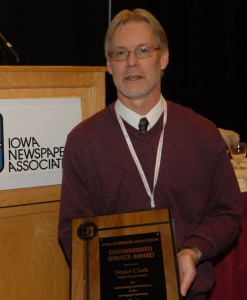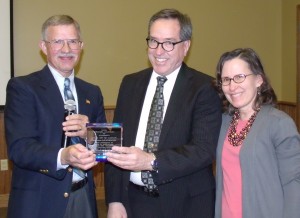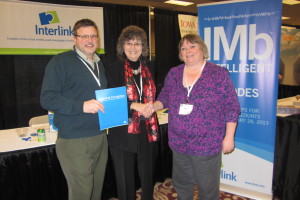
March 2013 Community Journal Newsletter
Enjoying the Texas Tradeshow
Christopher Maher, left, and Tim Acosta, center, both of the Kingsville Record, stopped by the Interlink booth at the Texas Press Association Midwinter Convention and Tradeshow in Houston in January and visited with Interlink Technical Support Services Supervisor Che’ Eddie. For more photos from the Texas Tradeshow, click here. Also, check out our photos from the Iowa Convention, click here.
Visiting at the Texas Convention
Interlink Senior Sales and Marketing Manager Helen Sosniecki visits with Tim Waltner, left, publisher of the Freeman (S.D.) Courier, and Marc Richard, vice president and operations manager of Fackelman Newspaper Group, publishers of the Ennis Daily News. Waltner, the recipient of the 2012 International Society of Weekly Newspaper Editors’ Eugene Cervi Award, was the Hall of Fame speaker at the Texas Midwinter Convention.
Reports that we are dying are greatly exaggerated
By Cheryl Wormley
President, International Society of Weekly Newspaper Editors
Back in 1897, James Ross Clemens was ill. Not-so-careful passing on of information resulted in word that Samuel Langhorne Clemens, better known by his pen name of Mark Twain, was dying in London. When an enterprising reporter decided to check on Twain before publishing his demise, the author responded, “The report of my death was greatly exaggerated.”
Morley Safer, during his Jan. 6 “60 Minutes” report about the newspaper industry, glibly stated, “The facts of life are that newspapers are folding all over the country. It’s a dying business.” His example was the New Orleans newspaper, The Times-Picayune, which recently cut back from publishing seven days a week to three days.
When it comes to newspapers, there are two cousins – large metro dailies and community newspapers. The latter includes weeklies and small dailies (publishing three or fewer days a week). Safer as well as reporters and broadcasters from media giants across the United States and around the world owe it to the public – and to community newspaper owners and staffers – to perform due diligence to determine which of the newspaper cousins is near death and which is alive. Only then, should they should report their findings.
It is the large metro daily newspapers, which make up less than 5 percent of all U.S. newspapers, that are struggling from declines in readership and advertising, printing less often or ceasing publication entirely.
While it is painful to see our metro-daily-newspaper cousins faltering, we, the community newspapers, are not dying. Like Twain, community newspapers say, “Reports of our dying are greatly exaggerated.”
Much has been published and broadcast about the decline of metro dailies. It is time to shine a spotlight on the health and vigor of community newspapers and on our role in rural and suburban communities across the country.
Readership of our newspapers, mostly weeklies, is increasing and new community newspapers are being birthed. That the great investor Warren Buffett bought more than 60 community newspapers in 2012 suggests there is present and future value in the weekly and small-daily arm of the industry.
Community newspapers are doing well because people want to read about the actions of their town council and local school board, the results of high school sporting events and what’s happening in the business community. Readers turn to community newspapers for public notices, for obituaries and police reports and for engagement, wedding, anniversary and birth announcements. They expect keen and thoughtful editorials as well as a forum for their own opinions – letters to the editor. They read the advertisements, look at every photo and clip articles and photos to post on bulletin boards and hang on refrigerators.
A 2011 survey by the National Newspaper Association and the Reynolds Journalism Institute at the Missouri School of Journalism found that 74 percent of people in areas served by newspapers with circulations under 15,000 read one of those papers each week. They spend nearly 40 minutes reading the paper. Then, they share their newspaper with 2.3 more people.
We are watchdogs in our communities. We protect the public’s right to know and keep our readers informed about their communities – essential elements in a democracy.
As 21st century technology keeps enhancing the gathering and dissemination of news and information, community newspapers aren’t standing idly by. We are in the fray, taking advantage of the immediacy that technology offers. We have developed revenue-producing websites, and we interact with our communities and our readers on email, Facebook and Twitter.
Community newspapers are very much alive. As Bill Tubbs, publisher of The North Scott Press and a member of the International Society of Weekly Newspaper Editors, wrote in an editorial Jan. 16, “Morley Safer, you’ve done us wrong, but here’s an offer you can’t refuse. Come to Eldridge (Iowa) and spend a week with our staff.”
Any of the more than 8,000 community weekly newspapers in the U.S. extend a similar invitation not just to Safer but also to everyone who wants to see the healthy cousin. Interview the folks in Freeman, S.D., about the Freeman Courier; the high school students in Pittsfield, Ill., about the Pike Press; the families in Falmouth, Maine, about The Forecaster; the government officials in Espanola, N.M., about the Rio Grande Sun; or the business owners in Woodstock, Ga., about The Cherokee Ledger-News and set the record straight.
Cheryl Wormley is publisher of The Woodstock (Ill.) Independent and president of the International Society of Weekly Newspaper Editors. She can be contacted at c.wormley@thewoodstockindependent.com.
Subscriptions vs. Ads
Kansas publisher launches tri-weekly newspaper with revenue business model centered on subscriptions
By Angela Kurtz
Associate Marketing Manager
Ben Franklin’s Theory of Operation.
For the record, I should state that Benjamin Franklin neither promoted any real theory of operations nor endorsed one, at least not that I am aware. However, Larry Hiatt, owner and publisher of Columbus News Report in Columbus, Kan., uses this descriptive term to explain the business model under which he set about building and growing his community newspaper.
Located in the southeast corner of the state, less than 30 miles from Joplin, Mo., the Hiatts publish the Columbus News Report three times a week serving a population of just over 3,200 residents with roughly 4,500 in their trade territory.
He and his wife and business partner, Sharon, took an atypical approach to starting their community paper, initially pursuing a subscription-based revenue stream in lieu of advertising dollars to create the financial foundation of Columbus News Report.
So, what’s the link to Benjamin Franklin?
According to Larry, during the colonial times of newspaper printing, there was no large advertising base of grocery stores and auto dealerships to sustain the printing and delivery costs of community papers. There was simply news; news uniquely relevant to the individuals of that local community and not provided elsewhere.
Larry and Sharon firmly believe offering a quality newspaper, filled with information and stories and photos that community residents want to read, is not only worth the price of the paper but is sufficient to sustain a publication. This nontraditional approach to revenue growth guided the Hiatts through the early stages of growing their business by focusing on earning subscriptions and not advertising dollars.
The Hiatts had returned home to Columbus to enjoy retirement, but not long after their arrival, Larry said that the daily paper that had been serving multiple locations decided to close its Columbus office and merged with another paper in the area. Larry attributes the move to the diminishing advertising base in Columbus.
As the former daily both merged and changed frequency in October 2010, Larry and Sharon published their first paper that same month. Having been in the industry for more than 50 years, the Hiatts fully understood the commitment and the level of risk they were undertaking by starting their business in their retirement years, and during tough, economic times. But because of their experience and industry knowledge, they were quickly able to identify their costs and calculate how many subscribers were needed to sustain the publication in the absence of large amounts of advertising dollars.
Knowing their breakeven point, they targeted city and rural residences, and individuals in surrounding communities by mailing six issues to each of these groups over several weeks’ time. Larry quickly points out that he and Sharon knew they were taking a financial risk by not aggressively seeking advertising dollars and that earning revenue purely on subscriptions “is definitely not the easy way to do it!”
However, their dedication to providing a quality paper filled with local information including sports, school lunch menus, city council and school board meetings drove Larry and Sharon to successfully obtain several hundred subscriptions within the first few months of operation. Within a year’s time, at a 3-month subscription rate of $10 per month for 13 issues, subscriptions rose to over 1,000 for their community of about 3,200 residents.
Columbus News Report typically runs eight pages Mondays and Wednesdays with Friday’s paper usually running 10 pages. The Hiatts also publish special editions about four times a year highlighting seasonal activities and local events for the community such as Columbus Days and a Christmas edition. These editions are usually 14 to 20 pages.
Now, I would be remiss to advance the theory that the Hiatts completely ignored advertising dollars as a source of revenue. That is certainly not the case.
Larry and Sharon understood the importance of those dollars, but their focus continued to be on producing a quality publication community residents would happily purchase to get the local information that mattered to them. With the success of growing their subscriptions, advertisers came to the Columbus News Report, and now advertising dollars makes up about half the total revenue for the publication.
Larry and Sharon have seen their share of challenges these past two and a half years, not the least of which is starting a new business in an industry that many outsiders believe is quickly fading.
The Hiatt’s experience, however, is the antithesis to this doomsday belief, and Larry considers their commitment to producing and delivering a quality product to the consumer is what sustains them and has brought them success. This notion of delivering value to the consumer is certainly not exclusive to the newspaper industry, and as Larry believes, the newspaper industry has lost sight of this.
Perhaps the future success of the community newspaper lies in the dedication to deliver quality, local news, at a value determined by the consumer, every time you deliver the paper.
It’s working for Larry and Sharon.
“I try to put the same things Ben Franklin would have put in his paper. What we’re trying to do here is recreate the identity of our local community,” Larry said.
Survey: Community newspaper readers continue to prefer papers for local news
From National Newspaper Association
COLUMBIA, MO—Community newspaper readers, surveyed recently, still say they prefer their local papers for getting their news and information. The survey was conducted in small U.S. towns and cities where the circulation size of the local newspaper was 15,000 or less.
The survey was conducted for the National Newspaper Association by the research arm of the Reynolds Journalism Institute at the University of Missouri School of Journalism. This is the survey’s seventh year.
Click here for link to survey.
“Every Door Direct Mail” a new revenue opportunity for your newspaper
By Mitzi B. Welborn
Mailing Solutions Specialist
U.S. Postal Service
With Every Door Direct Mail® service from the U.S. Postal Service®, potential customers can reach the customers who matter most to your business – in nearby neighborhoods. Postage will be as low as $.170 – and you won’t even need to know individual names or street addresses. You can simply identify the neighborhoods you want to target, and your printed piece is delivered to every active address in that target area.
You probably have seen that paragraph on websites, in print media, on television and heard from carriers and/or Postmasters many times. When it was initially launched, many printers and list providers saw the program as competition and not as an opportunity.
However, since then, many of them have become the Postal Service’s biggest sellers of Every Door Direct Mail. Some of the biggest online printers have embraced this program and are offering turnkey programs to both small and large business customers. Franchise printers like The UPS Stores, PostNet Stores, Minuteman Press, and Allegra printing have added Every Door Direct Mail to their sales menu, along with many others.
If you have not considered “Every Door Direct Mail” as another tool in your advertising arsenal, it is not too late.
Many newspapers throughout the country have added this product offering to their advertising portfolio. They have presented it to new businesses that want to introduce themselves to the community or promote a one-time event to a specific targeted area. It is great for announcing new store openings, sales, or other major events in solo or in conjunction with their newspaper advertising.
For weekly newspapers, it allows you to offer a marketing program to potential clients who want the flexibility of distribution on the days that your newspaper is not in the home. You can sell it to your business customers who want to reach homes during the week for a weekend event. The Postal Service’s new and enhanced website provides everything that you need to execute your customer’s request, except the printing and newspapers can handle the rest.
As a trusted member of the community, you can offer the personal touch that many of your customers like. Newspapers are rooted into the community which they serve. They are active participants in the communities. You know the demographics and the neighborhoods that your neighbors and neighborhood businesses would like to target. You have the printing capability to provide your customers with hands-on customer service that they have grown accustomed to.
Don’t let this new revenue stream for your company pass by. Learn more at www.usps.com/everydoordirectmail.
Mitzi Welborn may be reached at mitzi.b.welborn@usps.gov
Saturday mail loss would sting worst in small towns with Saturday papers
From National Newspaper Association
Why do small town newspapers publish on Saturdays?
The Saturday paper isn’t only for football as it is in many Texas towns, said Mary Judson, publisher of the Port Aransas South Jetty in Texas. It provides coupons for the sales, announcements for Sunday church events and breaking news stories of small towns.
But it was sports that led the Times-Leader, a 6,900-circulation twice-weekly in the southwestern Kentucky town of Princeton, to start its Saturday paper. Princeton is nestled in the flat farmlands of the state; a community steeped in history, having a downtown where there are few vacant buildings, with strategic highways I-69 and I-24 running through the country. It is home to the University of Kentucky Research and Education Center, a hotbed for agriculture research through the state’s land-grant university.
Until 1992, two weeklies competed head to head. When they merged, a Saturday paper was created and the weekly became a twice weekly, publishing Wednesdays and Saturdays.
It is mailed through seven post offices in five counties. The publisher trucks bundles of newspapers to those post offices between the Friday night printing and Saturday’s dawn to get into mailboxes.
For Princeton, like most towns, the mailed newspaper has no substitute.
“Although there are four dailies with circulation in the area, none has more than a few hundred readers in Princeton,” according to Publisher John S. (Chip) Hutcheson III. “The Times Leader circulates 5,400 papers each issue in Princeton, providing strong coverage of local government, schools, churches, civic clubs and police activity. Churches often use the Saturday paper to promote activities on Sunday. In this rural community, it is viewed as a major community-builder. It has a locally written opinion page both Wednesday and Saturday. Each issue of the paper ranges from a minimum of 24 pages to 36 pages. With a struggling radio station (in town), the newspaper is the only comprehensive news agent for the community.”
It will be newspapers like the Times Leader and the South Jetty that will be most hurt by the Postal Service’s announcement that it wants to end Saturday mail delivery. Although Congress has not yet agreed with that decision, the U.S. Postal Service wants to provide the opportunity for some industries to mail on Saturdays, but not others. Newspapers would either have to find a new way to reach readers or change to a different delivery day.
But for a newspaper like the Times-Leader, picking a different day isn’t easy. A Friday paper would miss the sports scores from those Friday-night games. Mondays would miss the church news and the sales. And killing that Saturday issue would deprive readers and eliminate Saturday advertising revenue.
“Newspaper personnel have been flooded with questions from family, friends and readers about what the paper would do (if Saturday mail stopped),” Hutcheson said. “Frankly, there is no good answer.”
The Postal Service has blamed its service reductions on the Internet. It is losing $25 million a day but much of that is because Congress makes it aggressively sock away money into the federal Treasury for future health care plans. It has lost nearly 40 percent of its First-Class Mail in the past five years.
One question is whether reducing service will stop the bleeding or accelerate it. In 2010, USPS said it could save more than $3 billion with five-day delivery. Now it says the cost savings are closer to $2 billion. Its regulator, the Postal Regulatory Commission, disagreed with the cost savings in 2010, and found the potential savings much less.
The PRC questioned whether USPS could handle delivery of all the held-back mail on Monday. In 2010, slowing delivery because of Monday holidays increased the Tuesday load by 64 percent, causing delays of that mail in the system throughout the rest of the week. Consistent Saturday closings could create the same waves of delay. USPS estimated that up to 25 percent of First-Class Mail would be delayed in a five-day delivery environment, and some of it could be delayed up to five days.
In that mail are small business invoices, checks and credit card authorizations—another worry of Hutcheson’s and Judson’s. Small newspapers, like most small businesses, run on tight cash flows. Today’s checks from yesterday’s advertising and subscriptions pay for tomorrow’s printing. As they are affected, so will their small-business advertisers be affected, which could create a downward spiral in a barely-recovering economy in many parts of America.
The bigger question is: what sort of Postal Service does America need? The Postal Service says the public supports dropping Saturday delivery. But whether the public is aware of the risks to the economy, particularly in small towns, is debatable. For most, the mail is taken for granted, even in a world where texts and e-mails have long since overtaken mail’s immediacy. Mail still supports more than $1 trillion in economic activity, according to a biennial study of the Envelope Manufacturers Association. And mailers pay for USPS, not the general public.
To some the Saturday football scores may seem trivial next to all of that. But if you’ve ever lived in a small town, you know that Saturday paper and its game news is anything but trivial.
NNA challenges Valassis, Inc. postal deal in Federal Court
From National Newspaper Association
WASHINGTON DC — National Newspaper Association earlier this month filed a brief in the U.S. Court of Appeals for the District of Columbia Circuit arguing that the Postal Regulatory Commission (PRC) failed to follow federal law in approving a historic postage discount deal between the private direct mail company, Valassis, Inc. and the US Postal Service.
In a joint filing with ValPak Direct Marketing Systems, Inc. and Valpak Dealers Association, Inc., NNA told the court that the PRC did not exercise its responsibility to protect against unreasonable harm to the marketplace. It also overlooked the threat to small businesses expressed by more than 200 community newspapers across America.
NNA joined the Newspaper Association of America in a lawsuit against the PRC after postal regulators approved a Negotiated Service Agreement (NSA) for Valassis that provides deep postage discounts if the direct mail firm is successful in enticing certain advertisers away from newspapers and related products and into a new Valassis weekend direct mail piece. This NSA was a first-ever attempt by USPS to formally square off against newspapers in the advertising markets through discriminatory contract postage rates. Both NNA and NAA protested the proposed deal at the PRC in the summer of 2012, but the PRC decided the deal is not anticompetitive because it is not offered at a below-cost postage rate and because it believes USPS should be encouraged to compete against newspapers for weekend advertising inserts.
Among NNA’s claims are that the deal will have a heavy impact upon hundreds of newspapers across the country that qualify as small businesses and that the discounts will distort local advertising in hundreds of marketplaces, many of which are already economically distressed.
NNA attorney Steven Douse, an antitrust attorney with the Nashville, TN, law firm King & Ballow, is critical of the Commission’s attempt to apply federal antitrust laws to the Postal Service’s decision to grant special discounts to a single special-privilege mailer.
“Antitrust laws are designed to function in unregulated markets,” Douse said. “But here the dominant firm (USPS) has a statutory monopoly with legally enforced barriers to entry….The Commission failed to realize that because of the postal and mailbox monopolies, one of the competitive responses that would normally be open to firms affected by the NSA—entry into the postal space by providing mailbox delivery—is foreclosed. It forces firms to compete with the Postal Service and Valassis with one hand tied behind their backs.”
NNA President Merle Baranczyk, publisher of the Mountain Mail in Salida, CO, said NNA’s appeal of the PRC decision is part of a unified industry effort to achieve a fair competitive environment.
“The Postal Service has seriously diminished newspapers’ trust by initiating this special deal with one single company,” Baranczyk said.
“This NSA demonstrates that USPS is willing to inflict intentional damage upon hundreds of its newspaper customers around the nation. We are disappointed the PRC does not realize the Postal Service’s role as a government-protected monopoly should forestall special deals like this. NNA believes USPS, in its desperation to solve financial problems, is grasping at straws to find new revenues. This particular straw should be strictly off limits. There should be no NSAs for advertising. The markets all over the country are already fully competitive and USPS can achieve nothing more than exploiting its monopoly to the detriment of tax-paying newspaper businesses and the communities they serve. We look forward to a full hearing of our concerns by the appeals court.”
Interlink welcomes…
Angela Kurtz
New Associate Marketing Manager joins Interlink
Interlink is pleased to welcome Angela Kurtz to the staff in the new position of Associate Marketing Manager.
Angela comes to Interlink with experience in both marketing and public relations. Her previous employment focused on improving customer satisfaction within a large, orthopedic practice, while establishing and maintaining relationships with referring physicians.
Angela most recently was an adjunct instructor in political science at Lake Michigan College. She has both bachelor’s and master’s degrees from Texas Tech University in Lubbock.
Outside the office, Angela enjoys spending time with her husband and two children, reading and running long distances when the Michigan weather is cooperative.
Angela may be reached at angela@ilsw.com
Take a bow…..
Iowa honors Max Heath for postal work
National Newspaper Association Postal Chair Max Heath received an Iowa Newspaper Association Distinguished Service Award during the annual INA Convention in Des Moines.
The award honored Heath for his role as the community newspaper industry’s postal expert, noting that “Max Heath knows the USPS like the back of his hand.”
In praising Heath for his assistance and trainings to countless newspapers, it was noted that Heath “has counseled thousands of newspapers on distribution issues, and he is an indispensable partner in advising regulators and Congress on postal policies affecting newspapers.”
The presenter, Bill Tubbs of the North Scott Press, also noted that “it is hard to find a community newspaper that has not been touched in some way by this devoted believer in newspapers.”
–Helen Sosniecki
Clark receives Distinguished Service Award
Tipton (Iowa) Conservative & Advertiser Publisher Stuart Clark received an Iowa Newspaper Association Distinguished Service Award during the annual INA Convention in Des Moines.
The award honored Clark for his work with both his newspaper and his community.
It was noted that “When it comes to his newspaper, Clark places a strong emphasis on reporting fairly, accurately and honestly. At times, he has likely sacrificed profit and popularity to make sure readers get the news without added opinion or influence.”
Clark also was praised for caring for his employees as if they were family, for his involvement with economic development, for his generous donations of advertising to local charities, art, music and sports programs and all “without ever drawing attention to himself.”
The presentation concluded: “To put it simply, Clark does what needs to be done to make sure his community and newspaper keep on keeping on.” Photo by Keith Textor, EggRocket Photography
–Helen Sosniecki
Iowa honors Stanley with Publisher Award
New Hampton (Iowa) Tribune and Nashua Reporter Publisher Dave Stanley received an Iowa Newspaper Association Master Editor-Publisher Award during the annual INA Convention in Des Moines.
The award honored Stanley for his “passion for people, which likely led him to the industry in the first place. He believes in his community, and he believes in his employees.”
The award noted that Stanley leads by example and is not a sit-at-the-desk type of person, instead choosing to be “out and about in the communities fostering relationships and taking the time to understand the needs of the newspapers’ readers.”
The presentation added: “The last several years have brought challenges and great opportunities. Stanley has embraced changes in technology, shown a tireless work ethic and continues to put his employees before himself.” Interlink photo/Helen Sosniecki
–Helen Sosniecki
Iowa honors Wiseman with Publisher Award
Armstrong Journal and Sac City Sun (Iowa) Publisher Jerry Wiseman received an Iowa Newspaper Association Master Editor-Publisher Award during the annual INA Convention in Des Moines.
The award honored Wiseman for being “a passionate advocate for newspapers and the communities they serve.”
The award noted that Wiseman is “known for his strong code of ethics and objective vision.” He was praised for providing “an opportunity for people to make a living for their families while making a meaningful contribution to the communities they call home.”
The presentation concluded: “A man of his word and someone who understands what it takes to create good community journalism, Wiseman treats people with the respect they deserve and earns their respect in return.” Photo by Keith Textor, EggRocket Photography
–Helen Sosniecki
Judson named to Texas Hall of Fame
Mary Henkel Judson, editor and co-publisher of the Port Aransas South Jetty, was one of four inductees into the Texas Newspaper Foundation Hall of Fame in January during the Midwinter Conference and Trade Show at the Westin Galleria in Houston.
According to the Texas Press Messenger, the Austin-based Texas Newspaper Foundation created its hall of fame in 2006 and inducts up to four exemplary men and women of the newspaper business each year.
The Messenger called Judson, the Texas Press Association’s 113th president, a trailblazer in the Texas newspaper industry. More than 100 years after the founding of Texas Press Association, Judson became the first woman to lead the organization. According to The Messenger, Judson served as president of South Texas Press Association (1980-81) and Texas Gulf Coast Press Association (1994-95). She and her husband, Murray Judson, are serving as co-presidents of TGCPA for 2012-13.
–Helen Sosniecki
Business of the Year honors
Journal-Eureka owners Jim and Bridget Johnson, right, accepted the Business of the Year award from Bill Feldmann, Chamber president, at the Anamosa (Iowa) Chamber of Commerce dinner Jan. 24. Feldman said the award was in appreciation for their contributions that improve communication, education, business, tourism and lives in Anamosa and throughout Jones County. The Johnsons bought the newspaper in April 2012. Anamosa Journal-Eureka photo
Texas Press Association winners
 Michael and Deborah Hawkins, center, owners of the Comfort News in Comfort, are congratulated by Interlink Senior Sales and Marketing Manager Helen Sosniecki and Interlink Technical Support Services Supervisor Che’ Eddie for winning an Interlink Circulation conversion during the TPA conference in January in Houston.
Michael and Deborah Hawkins, center, owners of the Comfort News in Comfort, are congratulated by Interlink Senior Sales and Marketing Manager Helen Sosniecki and Interlink Technical Support Services Supervisor Che’ Eddie for winning an Interlink Circulation conversion during the TPA conference in January in Houston.
Iowa Newspaper Association winners
Dan Evans, owner of the Lime Springs Herald, and Editor Marcie Klomp are congratulated by Interlink Senior Sales and Marketing Manager Helen Sosniecki, center, for winning an Interlink Circulation conversion during the INA conference in February in Des Moines.
What our customers are saying…
From Nebraska…
“My new circulation guy was very impressed with the training, and seems eager to study and learn more about the program now. I’m so glad. I was a bit worried before the training, but it was apparently a very positive experience for Doug, and gave him the confidence and understanding he needed that he wasn’t getting from our in-house training.”
Lisa Betz
Gering Citizen (NE)
Interlink Calendar
Memorial Day
May 27 – Memorial Day. Office closed.
Postal Calendar
Memorial Day
May 27 – Post offices closed. No mail delivery.
Interesting links…
Hyper-local chain making money focusing on print
Forbes takes a look at 37-year-old Texan John Garrett, who publishes 13 hyper-local editions of Community Impact Newspaper, delivered free each month to 855,000 homes in the Austin, Houston and Dallas areas. http://www.forbes.com/sites/christopherhelman/2013/01/02/new-shoots-in-old-growth/
Magazine creates stir over freelancer pay
Atlantic wants to run professional writer’s piece, but doesn’t want to pay to do so. Check out this take on the situation. http://pandodaily.com/2013/03/06/the-future-of-journalism-its-time-to-pick-a-side/
Can good design save newspapers?
Polish newspaper designer’s redesigns for Eastern European newspapers have been winning awards and increasing circulation. http://www.ted.com/talks/jacek_utko_asks_can_design_save_the_newspaper.html
Ad-size capture tool for publications
Technical support analyst Melanie Goff shares this link about an ad-size capturing tool: http://www.google.com/patents?hl=en&lr=&vid=USPAT8230324&id=Hx8gAgAAEBAJ&oi=fnd&dq=newspaper+publications&printsec=abstract#v=onepage&q=newspaper%20publications&f=false
Share your circulation ideas
Have you conducted a circulation-building campaign that produced great results? Why not share it with other publishers and circulation managers in our next quarterly Interlink Community Journal? Email them to helen@ilsw.com or angela@ilsw.com












